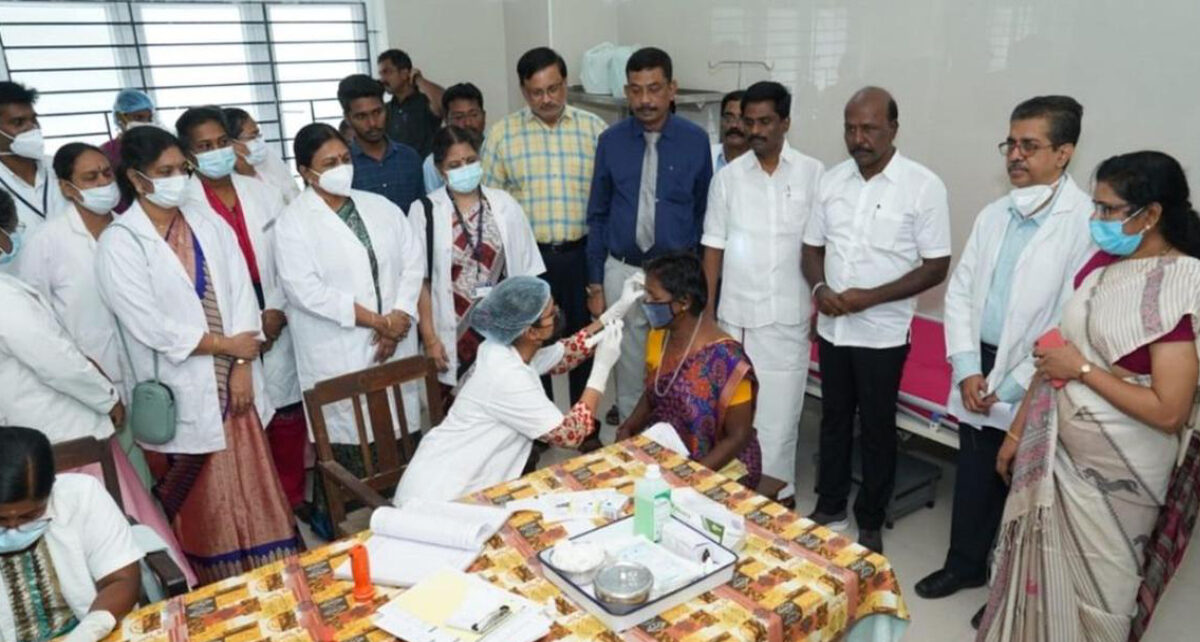Conjunctivitis, also known as ‘Madras Eye’ disease, is an inflammation of the conjunctiva — the clear tissue over the white part of the eye.

Health Minister Ma Subramanian at Regional Institutute of Opthalomology in Egmore inspecting the treatment given to Madras Eye disease. (Supplied)
Tamil Nadu is witnessing as many as 4,500 cases of conjunctivitis — also known as “Madras Eye” disease — per day, said state Health Minister Ma Subramanian on Monday, 21 November.
Conjunctivitis is an inflammation of the conjunctiva — the thin clear tissue that lies over the white part of the eye and lines the inside of the eyelid.
It affects mostly children, but adults can also get infected by it as the disease is contagious.
The disease is known as “Madras Eye” as the adenovirus, which causes the disease, was first identified in Madras in 1918.
From children to adults, people in all groups are affected by the disease in the state.
According to the health minister, apart from Chennai, people in three districts — Madurai, Salem, and Dharmapuri — are majorly affected by the disease.
“After the onset of monsoon, the state witnessed more than 1.5 lakh cases of the Madras Eye disease. The Regional Institute of Ophthalmology in Egmore, which used to receive 10 patients in the outpatient ward suffering from the disease in the first week of November, is now treating at least 80-90 cases per day,” Ma Subramanian told reporters.
இன்று சென்னை எழும்பூர் கண் மருத்துவமனையில் “MADRAS EYE” நோய்க்கான ஆய்வு மேற்கொள்ளப்பட்டது. #Masubramanian #TNHealthminister #MadrasEye #EyeInfection #inspection pic.twitter.com/Bj2WELcKZI
— Subramanian.Ma (@Subramanian_ma) November 21, 2022
The health minister also said that the disease was highly contagious.
“I am requesting people that if any of their family members are infected, try to self-quarantine for four days as it spreads to other people very quickly,” he said.
“In public, maintain social distancing. People should avoid buying medicine for the disease by themselves. Go see a doctor first and then take medication,” added Subramanian.
He also said that various centres had been set up across the state to control the spread of the disease.
There were 10 government-run medical centres for eye diseases in Chennai, he said.
“Hospitals have been asked to put up signboards with awareness messages [about the disease]. We are expecting the disease will not be anymore amongst the people after the second week of December,” said Subramanian.
The symptoms of the disease include:
When there are serious eye conditions that can cause eye redness, they may cause eye pain, a feeling that something is stuck in your eye (foreign body sensation), blurred vision and light sensitivity.
If you experience these symptoms, seek urgent care.
People who wear contact lenses need to stop wearing their contacts as soon as pink-eye symptoms begin.
If your symptoms don’t start to get better within 12-24 hours, make an appointment with your eye doctor to make sure you don’t have a more serious eye infection related to contact lens use.

May 04, 2024

May 04, 2024

May 04, 2024

May 04, 2024

May 03, 2024

May 03, 2024